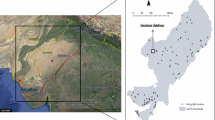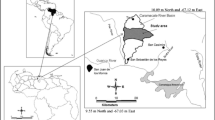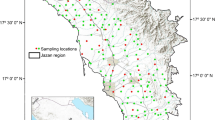Abstract
Appropriate land use and management requires a good knowledge about the main hydraulic properties of the soil, in particular soil moisture at field capacity (FC), permanent wilting point (PWP), and water holding capacity (HC). In the absence of direct measurements, these characteristics could be estimated from data on texture and organic matter content, using pedotransfer functions (PTFs). In this study, FC, PWP, and HC of predominant soil types in Cap Bon (Vertisols, Cambisols, and Calcisols), are estimated using Saxton and Rawls (Soil Sci Soc Am J 70:1569–1578, 2006) PTFs and complete sets of soil analysis data. Results show that when all soil samples (61) are taken together, obtained estimations were well correlated with measured values for FC (R2 = 0.72) and PWP (R2 = 0.72). Similar correlations were observed for Cambisols and Calcisols taken separately (R2 = 0.65–0.70.); but there was an overestimation of FC and PWP for Vertisols (percentage of clay > 50%). However, relatively weak relationships were observed between estimated and measured values for HC in all cases (R2 = 0.15). PTFs seem appropriate to be used in combination with remote sensing methods for generation of soil FC and PWP maps needed in irrigation and agriculture efficient management.
Access provided by CONRICYT-eBooks. Download chapter PDF
Similar content being viewed by others
Keywords
Introduction
The genetic study of soils leads naturally to assess their physical and chemical characteristics and fertility potential for improving their use. On a global scale, FAO has created a World Reference Base for Soil Resources (WRB) representing 32 reference soil groups (IUSS Working Group WRB 2006). WRB is a tool for better correlation between national soil classifications to compare similar soils in different parts of the world.
In Tunisia, soil resources present a great diversity with three predominant groups: alkaline soils developed on calcareous materials distributed in all regions, acid soils located in the extreme northwest of the country and the gypsic and saline soils located mainly in the center and the south (Mtimet 1999).
More than 37% of cultivated lands are used for cereals production and half of that area (1.5 million) is located in the north and dominated by iso-humic soils, brown calcareous soils, Vertisols and slightly developed soils (CPCS Classification 1967). Because of a long dry season and irregularity in rainfall, rainfed cereal crops are frequently subject to water deficit, particularly for soils with limited water holding capacity (Ben Hassine et al. 2003).
The holding capacity of soils represents the maximum water stored in the soil and accessible to plants. It is defined as the difference between soil moisture at field capacity (FC) and at permanent wilting point (PWP). FC is the water content of the soil after the excess water was drained and the downward flow has decreased. PWP is the lowest water content at which a plant can access water from soil. The matric potential corresponding to FC and PWP is commonly estimated at −33 kPa and −1500 kPa, respectively (Musy and Sautter 1991).
FC and PWP values are determined by direct measurements in laboratory: The principle is to drain saturated soil samples by the corresponding suction pressure. For each applied pressure, water retained after equilibrium, is determined by the gravimetric method. These measurement methods are time-consuming and expensive, especially when the number of samples is large (Schaap and Leij 1998; Schaap et al. 2001). Furthermore their values depend on the state of the samples used (disturbed or not). Therefore, models for estimation of these properties from other more available data such as texture were developed (Hall et al. 1977; Gupta and Larson 1979; Rawls et al. 1982; Vereecken et al. 1989; Rawls et al. 1991; Bastet et al. 1999; Pachepsky et al. 2006).
These models called pedotransfer functions (PTFs) (Bouma 1989) are a simple way to have good estimates of hydraulic properties instead of using more complex direct measurements (Rawls and Brakensiek 1982; McBratney et al. 2002), although their efficiency for different soil types remains questionable. Furthermore PTFs developed in one region or from one database had limited accuracy in other conditions (Williams et al. 1992; Tietje and Tapkenhinrichs 1993; Kern 1995; Wösten et al. 2001).
Among PTFs cited in the literature Gijsman et al. (2002) compared the performance of eight methods for estimating water retention parameters against field-measured data from across the USA and concluded that the texture-based method by Saxton et al. (1986) was the most precise. These latter PTFs have been successfully applied in several studies related to agricultural hydrology and water management, together with models like SPAW (Saxton and Wiley 2006), BUDGET (Raes 2002, Raes et al. 2006) and AquaCrop (Steduto et al. 2009).
The original Saxton et al. (1986) soil water tension equations were revisited by Saxton and Rawls (2006) who developed also relationships for conductivity and introduced adjustments for organic matter, density, gravel, and salinity. The Saxton and Rawls (2006) PTFs were calibrated using the USDA soil database of about 1722 samples of the (A) horizon and are used in many applications.
Soil properties maps are generally based on an extensive soil sampling and analysis and on the use of Krigging technique for spatial extrapolation. Recent development of remote sensing methods for generation of soil texture maps could be used for producing precise soil hydraulic properties maps needed in precision agriculture and for efficient irrigation management (Gomez et al. 2012; Lagacherie et al. 2013). However, this task requires the use of robust PTFs and appropriate methods to extrapolate properties obtained in soil surface to deep layers.
In this work, the use of texture and Saxton and Rawls PTFs for estimation of hydraulic properties will be tested for three soil classes prevailing in the Cap Bon region and results will be analyzed and compared to measured properties.
Materials and Methods
Studied Soils
The samples used in this study were taken in the Cap Bon region, northeast Tunisia, from 17 soil profiles distributed on three types of soil (Vertisols, Cambisols and Calcisols).
For each soil horizon of these soil pits (61 horizons), particles size, bulk density, soil moisture at permanent wilting point (PWP) and field capacity (FC) were determined at the soil analysis laboratory of Arras-France.
Saxton and Rawls Pedotransfer Functions
Data on texture and organic matter content were used to estimate soil hydraulic properties by the equations of Saxton and Rawls. Estimates have considered all of the soil horizons and concerned the water contents at field capacity (FC) and at permanent wilting point (PWP).
Saxton and Rawls PTFs are expressed as nonlinear polynoms using sand (S) and clay (C) percentages and organic matter content (OM).
PWP is defined as the volumetric soil moisture at 1500 kPa (θ1500)
Where
FC is defined as the volumetric soil moisture at 33 kPa (θ33)
Where
FC and PWP estimates are compared to measured values in order to assess the performance of these equations in estimating soil water content parameters.
Results
In a first assessment, the equations of Saxton and Rawls were applied to the entire set of data (61 samples). Results show relatively good estimations of FC and PWP in comparison with measured values, with similar coefficients of determination for both parameters (R2 = 0.72). FC and PWP values obtained by PTFs were used to estimate available water holding capacity (HC) of the considered soil samples. Estimated HC varied between 7.3 and 15.4% vol., showing a relatively narrow range compared to the measured values (2.3–19.9% vol.), with a poor linear relationship between estimated and measured values (R2 = 0.15).
In a second step, data of the different profiles were arranged under the corresponding three soil classes according to the World reference base for soil resources (IUSS Working Group WRB 2006): cambisols, calcisols and vertisol and results were analyzed separately for each soil type.
Performance of PTFs for Cambisols
The Cambisols (corresponding to Inceptisols according the USDA classification) are soils with a horizon at the beginning of differentiation. They are in a transitional phase of development, from a young to a mature soil. Their parent material is mainly from colluvial, alluvial, or aeolian deposits. These soils are characterized by slight to moderate alteration of parent material and the absence of appreciable amounts of illuviated clay, organic matter, and iron compounds. Most Cambisols have medium texture with high porosity, good water retention capacity and good internal drainage (Driessen et al. 2001). The Cambisols were reported in five surveyed sites (18 horizons). FC and PWP of these soils are increasing clearly with clay content.
The hydraulic properties estimated for Cambisols by the model of Saxton and Rawls have a good correlation with measured values (R2 in the range 0.6–0.7) (Fig. 8.1a). However weak relationship is observed between estimated and measured values of holding capacity (Fig. 8.1b).
Performance of PTFs for Calcisols
Calcisols are characterized by substantial secondary accumulation of lime. Most Calcisols have a medium or fine texture and good water retention properties. They are widespread in arid and semiarid areas (Driessen et al. 2001).
They were found in 28 horizons in eight profiles among the 17 considered ones. FC and PWP estimated by the Saxton and Rawls model for the Calcisols are also well correlated with measured values with R2 = 0.71 and 0.66 and RMSE of 5 and 7%, respectively (Fig. 8.2).
Holding capacity was poorly estimated by the Saxton and Rawls PTFs with a significantly smaller range of estimated values compared to measured values.
Performance of PTFs for Vertisols
Vertisols are churning heavy clay soils with a high proportion of swelling 2:1 lattice clays that forms deep cracks in drier seasons or years. They derive either from rock weathering products or fine sediments, which have the characteristics of smectite clay. These soils are found mainly in tropical, semiarid to (sub) humid and Mediterranean climates, the essential feature is the alternation of distinct wet and dry seasons. Heavy soil texture and domination of clay minerals lead to a narrow soil moisture range between water stress and water excess (Driessen et al. 2001).
Vertisols were found in four sites with a total number of samples of 15. They are characterized by high percentage of clay (>50%) and did not show a clear relationship between FC or PWP and clay percentage. The use of Saxton and Rawls equations to estimate FC and PWP of these soils resulted in overestimated values compared to measured ones (Fig. 8.3a). HC is also poorly estimated by the PTFs and a smaller range was observed for estimated HC as compared to measured values (Fig. 8.3b).
Statistical Evaluation
Statistical evaluation was performed through correlation coefficient and root mean square errors (RMSE) given in Table (8.1). The coefficients of determination and RMSE show that PTFs give larger deviations for Vertisols than for the other two soil types. These deviations are primarily related to the heavy texture of these soils.
Conclusion
In this work, Saxton and Rawls PTFs were tested for estimating hydraulic properties of three types of soil of the Cap Bon region (Vertisols, Cambisols, and Calcisols) using percentage of sand, clay, and organic matter of 61 samples from 17 soil profiles.
PTFs produced relatively good estimates of field capacity and permanent wilting point (R2 = 0.72) when considering all profiles and horizons (61 samples). However, holding capacity was poorly estimated with an R2 of 0.15 between measured and estimated values.
When considering separately soil classes, results show that estimated values of FC and PWP were well correlated with measured values for Cambisols and Calcisols (R2 = 0.65–0.70) whereas for Vertisols (clay rate > 50%), PTFs seems to overestimate both parameters. HC remained difficult to assess for the three soil types.
With recent progress in estimating texture and organic matter of soils from remote sensing images, PTFs are likely to become a common method for developing soil hydraulic properties maps (FC and PWP) needed for efficient irrigation and precision agriculture practices.
References
Bastet G (1999) Estimation des propriétés de rétention en eau des sols à l’aide de fonctions de pédotransfert: développement de nouvelles approches. Univ. d’Orléans
Ben Hassine H, Ben Salem M, Bonin G, Braudeau E, Zidi C (2003) Réserve utile des sols du Nord-Ouest tunisien évolution sous culture. Étude et Gestion des Sols 10:19–33
Bouma J (1989) Using soil survey data for quantitative land evaluation. Adv Soil Sci 9:177–213
Driessen P, Deckers J, Spaargaren O, Nachtergaele F (2001) Lecture notes on the major soils of the world. FAO, Rome
Gijsman AJ, Jagtap SS, Jones JW (2002) Wading through a swamp of complete confusion: how to choose a method for estimating soil water retention parameters for crop models. Eur J Agron 18:75–105
Gomez C, Lagacherie P, Bacha S (2012) Using Vis-NIR hyperspectral data to map topsoil properties over bare soils in the Cap Bon region, Tunisia. In: Minasny B, Malone BP, McBratney AB (eds) Digital soil assessments and beyond. Springer, pp 387–392
Gupta SC, Larson WE (1979) Estimating soil water retention characteristics from particle size distribution, organic matter percent and bulk density. Water Resour Res 15:1633–1635
Hall DG, Reeve MJ, Thomasson AJ, Wright VF (1977) Water retention, porosity and density of field soils. Technical Monograph. No 9. Soil Survey of England & Wales, Harpenden
IUSS Working Group WRB (2006) World reference base for soil resources 2006. World Soil Resources Reports No. 103. FAO, Rome
Kern JS (1995) Evaluation of soil water retention models based on basic soil physical properties. Soil Sci Soc Am J 59:1134-1141
Lagacherie P, Sneep AR, Gomez C, Bacha S, Coulouma G, Hamrouni MH, Mekki I (2013) Combining Vis–NIR hyperspectral imagery and legacy measured soil profiles to map subsurface soil properties in a Mediterranean area (Cap-Bon, Tunisia). Geoderma 209:168–176
McBratney AB, Minasny B, Cattle SR, Vervoort RW (2002) From pedotransfer functions to soil inference systems. Geoderma 109:41–73
Mtimet A (1999) Atlas des sols tunisiens. Ministère de l’Agriculture, Tunis
Musy A, Sautter M (1991) Physique du sol. Presses polytechniques universitaires romandes, Lausanne
Pachepsky YA, Rawls WJ, Lin HS (2006) Hydropedology and pedotransfer functions. Geoderma 131:308–316
Raes D (2002) BUDGET, a soil water and salt balance model: reference manual. Faculty of Agricultural and Applied Biological Sciences, Institute for Land and Water Management, Katholieke Universiteit Leuven, Leuven, Belgium
Raes D, Geerts S, Kipkorir E, Wellens J, Sahli A (2006) Simulation of yield decline as a result of water stress with a robust soil water balance model. Agric Water Manag 81:335–357
Rawls WJ, Brakensiek DL (1982) Estimating soil-water retention from soil properties. J Irrig Drain Div 108:166–171
Rawls WJ, Gish TJ, Brakensiek DL (1991) Estimation soil water retention from soil physical properties and characteristics. Advance in soil science. Springer–Verlag, New–York Inc., 16:213–234
Schaap MG, Leij FJ (1998) Using neural networks to predict soil water retention and soil hydraulic conductivity. Soil Tillage Res 47:37–42
Schaap MG, Leij FJ, van Genuchten MT (2001) Rosetta: a computer program for estimating soil hydraulic parameters with hierarchical pedotransfer functions. J Hydrol 251:163–176
Saxton KE, Rawls WJ, Romberger JS, Papendick RI (1986) Estimating generalized soil water characteristics from texture. Soil Sci Soc Am J 50:1031–1036
Saxton KE, Rawls WJ (2006) Soil water characteristic estimates by texture and organic matter for hydrologic solutions. Soil Sci Soc Am J 70:1569–1578
Saxton KE, Willey PH (2006) The SPAW model for agricultural field and pond hydrologic simulation. Chapter 17. In: Singh VP, Frevert D (eds) Mathematical modeling of watershed hydrology. CRC Press, pp 401–435
Steduto P, Hsiao TC, Raes D, Fereres E (2009) In AquaCrop-The FAO crop model to simulate yield response to water: I. Concepts and underlying principles. Agron J 101:426–437
Tietje O, Tapkenhinrichs M (1993) Evaluation of pedotransfer functions. Soil Sci Soc Am J 57:1088–1095
Vereecken H, Maes J, Feyen J, Darius P (1989) Estimating the soil moisture retention characteristics from texture, bulk density and carbon content. Soil Sci 148:389–403
Williams RD, Ahuja LR, Naney JW (1992) Comparison of methods to estimate soil water characteristics from soil texture, bulk density and limited data. Soil Sci 153:172-184
Wösten JHM, Pachepsky YA, Rawls WJ (2001) Pedotransfer functions: bridging the gap between available basic soil data and missing soil hydraulic characteristics. J Hydrol 251:123–150
Acknowledgments
The financial support of the ANR projects Digisol-Hymed and Almira is acknowledged.
Author information
Authors and Affiliations
Corresponding authors
Editor information
Editors and Affiliations
Rights and permissions
Copyright information
© 2017 Springer International Publishing AG
About this chapter
Cite this chapter
Alaya, I., Masmoudi, M.M., Lagacherie, P., Coulouma, G., Jacob, F., Ben Mechlia, N. (2017). Performance of Saxton and Rawls Pedotransfer Functions for Estimating Soil Water Properties in the Cap Bon Region-Northern Tunisia. In: Ouessar, M., Gabriels, D., Tsunekawa, A., Evett, S. (eds) Water and Land Security in Drylands. Springer, Cham. https://doi.org/10.1007/978-3-319-54021-4_8
Download citation
DOI: https://doi.org/10.1007/978-3-319-54021-4_8
Published:
Publisher Name: Springer, Cham
Print ISBN: 978-3-319-54020-7
Online ISBN: 978-3-319-54021-4
eBook Packages: Earth and Environmental ScienceEarth and Environmental Science (R0)







